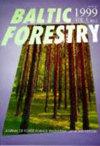花旗松(Pseudotsuga menziesii(Mirb.)Franco)球果在种子提取过程中的形态变异
IF 0.6
4区 农林科学
Q3 FORESTRY
引用次数: 0
摘要
本文使用四次多项式生成曲线对波兰Kołaczyce(一批)和Opole(两批)林区的花旗松(Pseudotsuga menziesii(Mirb.)Franco)球果的形状进行建模,并计算单个球果的表面积和体积。然而,由于经验系数的高度可变性,无法构建道格拉斯冷杉球果表面积和体积的广义方程。锥体的表面积和体积也是根据它们的长度和直径,根据用常数k1和k2校正的圆柱体和筒体的公式计算的。使用生成函数确定的第一批、第二批和第三批封闭花旗松球果的平均表面积分别为4348.4mm2、3857.0mm2和2844.7mm2,体积分别为27212.4mm3、21012.9mm3和12844.4mm3。根据固体的几何公式计算出的相应值,表面积分别为4332.0 mm2、3838.0 mm2和2862.9 mm2,体积分别为27366.0 mm3、20648.9 mm3和13375.3 mm3。开放锥的蒸发面积是封闭锥的五倍,差异具有统计学意义。使用Quanta 200扫描显微镜(FEIC)对取自花旗松球果中段的鳞片的外表面和内表面进行拍照。利用MultiScan Base软件包对鳞片形态特征元素进行了评价。道格拉斯冷杉鳞片的外表面和内表面在一些重要方面存在差异,类似于文献中对苏格兰松、银杉、欧洲落叶松和黑杨的报道。鳞片的外表面由具有明显突起的厚壁细胞形成,而内表面则显示出在种子和翅膀附近区域具有薄而磨损的壁的细胞。了解花旗松球果的几何形状及其鳞片的形态可能有助于优化这些球果的种子提取参数。关键词:种子提取、模型、形状曲线、表面积、体积、扫描电子显微镜本文章由计算机程序翻译,如有差异,请以英文原文为准。
Morphological variability of Douglas fir (Pseudotsuga menziesii (Mirb.) Franco) cones in the context of seed extraction
In the paper generating curves given by fourth-degree polynomials were used to model the shape of Douglas fir (Pseudotsuga menziesii (Mirb.) Franco) cones from the Polish Forest Districts of Kołaczyce (one batch) and Opole (two batches), and to calculate the surface area and volume of individual cones. However, it was not possible to construct generalized equations for the surface area and volume of Douglas fir cones due to the high variability of empirical coefficients. The surface area and volume of the cones were also calculated from their length and diameter based on formulas for a cylinder and a barrel corrected by constants k1 and k2. The mean surface area of closed Douglas fir cones determined for the first, second, and third batch using the generating function was 4,348.4 mm2, 3,857.0 mm2, and 2,844.7 mm2, and the volume was 27,212.4 mm3, 21,012.9 mm3, and 12,844.4 mm3, respectively. The corresponding values calculated from the geometric formulas for solids were 4,332.0 mm2, 3,838.0 mm2, and 2,862.9 mm2 for the surface area and 27,366.0 mm3, 20,648.9 mm3, and 13,375.3 mm3 for the volume. The evaporation area of open cones was found to be five times greater than that of closed cones, with the difference being statistically significant. The outer and inner surfaces of scales taken from the middle segment of Douglas fir cones were photographed using a Quanta 200 scanning microscope (FEIC). The characteristic elements of scale morphology were evaluated by means of MultiScan Base software package. The outer and inner surfaces of Douglas fir scales were found to differ in some important ways, similarly as it has been reported in the literature for the Scots pine, silver fir, European larch, and black alder. The outer surface of scales is formed by thick-walled cells with marked protrusions, while the inner surface reveals cells with thin, frayed walls in the region adjacent to the seeds and wings. Knowledge of the geometry of Douglas fir cones and the morphology of their scales may be helpful in optimizing seed extraction parameters for those cones. Key words: seed extraction, model, shape curve, surface area, volume, scanning electron microscope
求助全文
通过发布文献求助,成功后即可免费获取论文全文。
去求助
来源期刊

Baltic Forestry
农林科学-林学
CiteScore
1.60
自引率
0.00%
发文量
23
审稿时长
>12 weeks
期刊介绍:
The journal welcomes the original articles as well as short reports, review papers on forestry and forest science throughout the Baltic Sea region and elsewhere in the area of boreal and temperate forests. The Baltic Sea region is rather unique through its intrinsic environment and distinguished geographical and social conditions. A temperate climate, transitional and continental, has influenced formation of the mixed coniferous and deciduous stands of high productivity and biological diversity. The forest science has been affected by the ideas from both the East and West.
In 1995, Forest Research Institutes and Universities from Estonia, Latvia and Lithuania
joined their efforts to publish BALTIC FORESTRY.
 求助内容:
求助内容: 应助结果提醒方式:
应助结果提醒方式:


